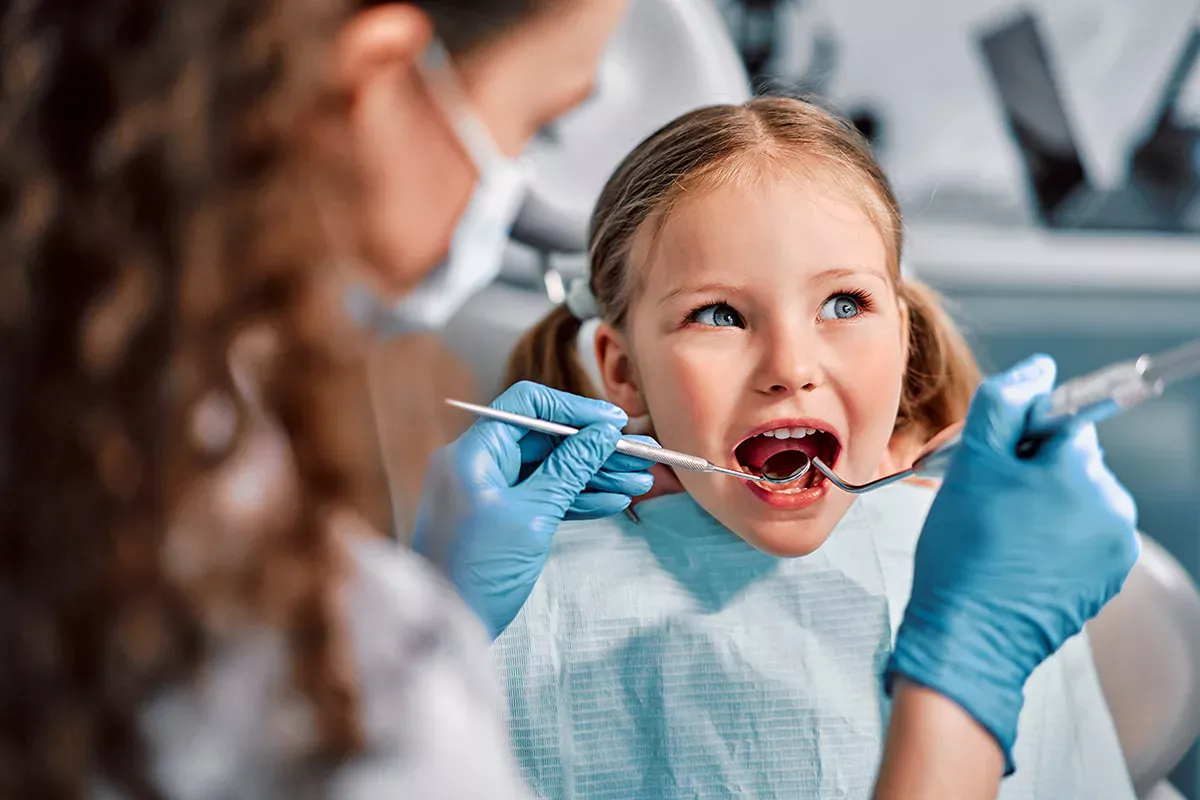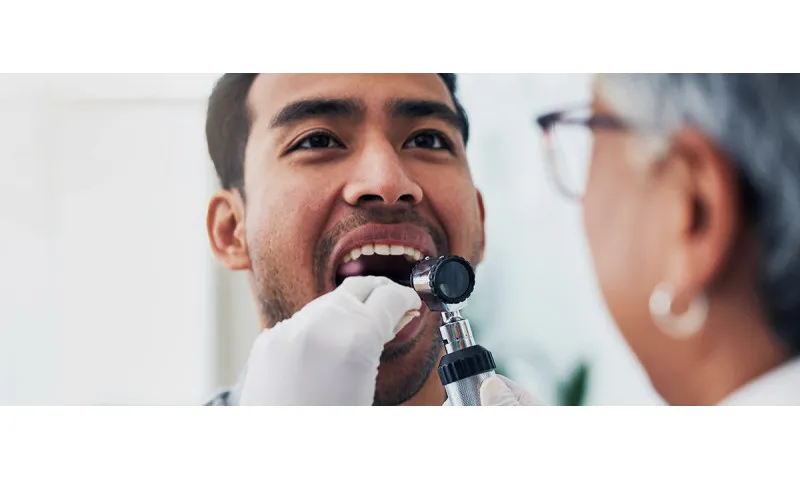Definition: What is black stain?
Most people think of one thing when they see dark spots on their teeth: poor oral hygiene. However, this is not always the case - for example, in the case of black stain (technically known as "melanodontia"). This is a black, green or orange discolouration of the teeth that mainly occurs in childhood and adolescence. It occurs regardless of whether the affected person brushes their teeth well and regularly.
The unsightly, very firmly adhering colour change usually forms a garland around the neck of the tooth - i.e. close to the gums. It often disappears again by itself in adulthood. Why does this happen? This is not known. The good news is that the stains are not harmful to the teeth - they do not attack them. And there's another real surprise: black stain even protects against tooth decay! Studies have already shown that those affected suffer less frequently from tooth decay.
Why does black stain occur?
The stains on the teeth are caused by colouring bacteria that are deposited on the teeth. The discolouration is then caused by a combination of saliva components and bacterial metabolic products. It is interesting to note that very few people have the bacterial metabolites that play a role here in their bodies.
Caries or discolouration? Recognising black stain
Many parents get a real fright when black spots suddenly appear on their child's teeth. Understandable! After all, we usually associate discoloured teeth with tooth decay in the first instance. However, black stain can be easily distinguished from caries - by the aforementioned garland-like border on the gums, which cannot be removed even by intensive tooth brushing.
Caries is a different story. It is caused by plaque - a soft plaque that forms on the teeth if we do not brush them properly and regularly enough. Over time, it hardens and turns into tartar. Both can develop into tooth decay over time. However, unlike black stain, this does not appear as discolouration on the gum line across several teeth, but as a small black or brown spot on a single tooth, if at all. Caries is often not even discovered at home, but only detected during a visit to the dentist.
Good to know:
Did you know that milk teeth are particularly susceptible to tooth decay? This is because their enamel is only half as thick as that of permanent teeth. You can read here how children brush their teeth properly and why cavities in milk teeth can also have an impact on "adult teeth":
Diagnosing black stain - what happens at the dentist
As a mum or dad, are you convinced that your child is only affected by harmless melanodontia and has no other dental disease? Then you should still make an appointment with a dentist. The experts will examine your child's teeth carefully and check whether your suspicions are correct. In most cases, the dentist only needs to take a close look in the mouth to recognise whether it is black stain or dental disease. However, UV light can also be used to confirm the suspicion. In some cases, the dentist may also take an X-ray of the teeth to fully check the condition of the teeth.
After the examination, the dentist will advise you on how to deal with the harmless stains. Even if they don't damage the teeth, they often cause embarrassment and self-confidence problems, especially in older children. That doesn't have to be the case. You can find out how to treat black stain in the next section.
Treating melanodontia - Not necessary, but often desired
There is usually no medical reason to treat black stain - you have already learned that the discolouration is harmless and cannot damage your teeth. Nevertheless, hardly anyone wants to walk around with unsightly black edges on their gums. That's why the dentist usually offers several removal options, depending on the severity of the discolouration.
Professional teeth cleaning
In most cases, it is sufficient to have your teeth professionally cleaned. This is a deep and intensive cleaning of the teeth, which dental experts carry out in a dental practice using special instruments. They remove all soft and hard plaque on the tooth surfaces, in the spaces between the teeth and in the so-called gum pockets, if you have any. Gum pockets form when the periodontium is damaged by
Gingivitis (inflammation of the gums) and periodontitis. In this case, the gums detach from the tooth, creating so-called gingival pockets. Pathogenic bacteria can settle and hide particularly well in these pockets.
Professional teeth cleaning can also be carried out on children. It can help to lighten the discolouration caused by black stain. Regular professional dental cleanings can also ensure that melanodontia does not develop in the first place. But it is important to know: Even after a professional dental cleaning, removed black stain can develop again. It can therefore make sense to have your teeth cleaned again every six months in order to counteract this at an early stage.
Good to know:
Would you like to find out more about what exactly you can expect from a professional dental cleaning, how effective it is and what costs you can expect? Then read on here:
Teeth whitening treatments
In some cases, stubborn black stain persists even after professional teeth cleaning. In theory, there are ways to whiten teeth. However, these are usually applications that are intended for adults. However, it is almost exclusively children and adolescents who are affected by black stain. You can find out who is eligible for teeth whitening and what options are available in our articles "Tooth discolouration: Where they come from and how they disappear" and "Bleaching: whitening teeth - but the right way!". It is important that you seek advice from your dentist. This is the only way to get a comprehensive and reliable overview of how to deal with black stain in a healthy way.
Preventing black stain - is that possible?
It is not easy to prevent melanodontia or avoid it altogether. People who have this predisposition can hardly counteract it. This is why the advice to pay more attention to oral hygiene is rather inappropriate and often hurtful. After all, black stain is not caused by poor oral hygiene. Nevertheless, it is of course immensely important that parents start practising regular and thorough dental hygiene with their children at an early age. In this way, they prevent caries from forming on the sensitive milk teeth - and yes, there is hope that this will prevent the black stain from taking on larger proportions. With regular tooth brushing, the characteristic ring-like discolouration can be noticed early on so that parents can react immediately and make an appointment with a dentist.
Proper care for children's teeth - from the first milk tooth
What is the ideal dental hygiene regime for children? It is important to start as soon as the first tooth has erupted - this is usually the case at around six months of age. At this tender age, however, dental care must also be particularly gentle so as not to damage your baby's sensitive oral mucosa.
You can either brush the teeth with a damp cloth or use a very soft baby toothbrush, such as the baby toothbrush from Curaprox. The bristles are so soft that there is no risk of damaging the oral mucosa. The brush head is also soft and rubberised.
If children learn how to use a toothbrush through play, there is a good chance that brushing their teeth will not feel like a burden later on - and that is important. Because, as you have already learnt, milk teeth also need to be protected against tooth decay and other diseases.
Good to know:
How do you brush baby teeth? When can you start using toothpaste? And: What tips and tricks are there to make it fun for your baby? You can read all about it here:
Conclusion: Black stain is harmless, but often stressful - encourage children!
Does your child put a lot of effort into brushing their teeth - and yet black stain still forms? This can be very frustrating and stressful. Because discoloured teeth are also associated with shame for children. It is now important to make it clear to your child that they have done nothing wrong and that the black stains on their teeth would have formed even with the best oral hygiene. Also try to empower your child and take away their shame. Make a dentist appointment together and get good advice. There is definitely a solution to restore the whiteness of the teeth.
Sources:
Ambos: Child protection medicine.
Bartsch, Birgit: BLACK STAIN Epidemiological investigation and quantitative detection of cario- and periodontopathogenic germs using real-time PCR, Dissertation, Status: 2010.
Deutsche Zahnarztauskunft: Melanodontia unsightly but not dangerous.
Practice for implantology, periodontology and aesthetic dentistry, Dr med. dent. Thomas Petersen: Black teeth: Black stain / melanodontia - black tooth discolouration.
Pschyrembel Online: Melanodontics.
Zukunftzahn GmbH: Black stain - black tooth discolouration in children and adolescents.
All websites last accessed on 29 May 2024.
 Swiss premium oral care
Swiss premium oral care







